The Split Rock Succulent, or Pleiospilos nelii, is an uncommon species of succulent native to South Africa. It grows naturally in semi-arid areas above an elevation of about 2850 feet.
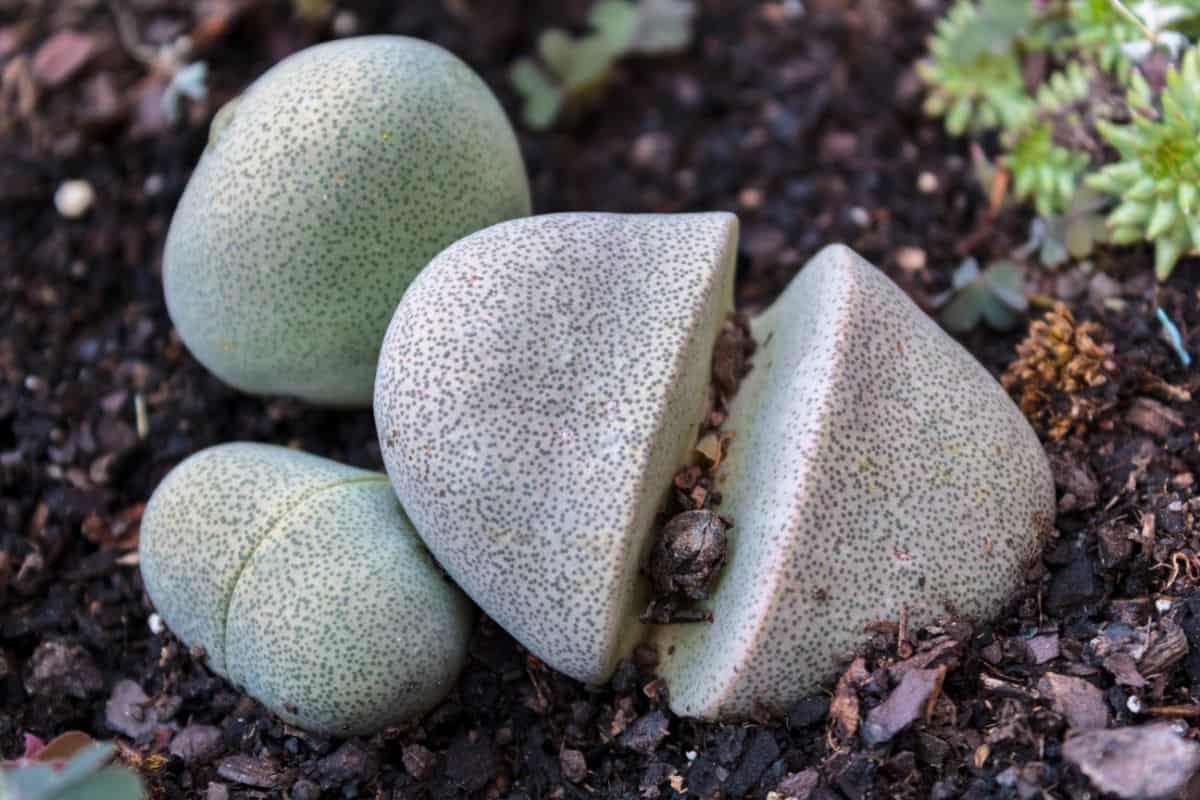
The name ‘Split Rock Succulent’ comes from the succulent’s unique appearance. As you may be able to guess, the bulbous leaves resemble rocks that have been split in the center.
However, Split Rock isn’t the only name these plants go by. You may also hear them referred to as Cleft Stones and Mimicry Plants, again because of their ability to mimic the appearance of stones.
The plant’s scientific name was given in honor of South African botanist Gert Cornelius Nel. The succulent genus Nelia was also named after him.
Despite its unique appearance, P. nelii is not the only succulent with a rock-like façade. Other rock-like succulents include Lithops and Dinteranthus. Collectively, these succulents are also sometimes referred to as mesembs.
Jump to:
Split Rock Succulent Appearance
| Name: | Pleiospilos nelii |
| Soil: | Well-draining soil |
| Blooming: | Spring or Autumn |
| Light: | Full sun to partial shade |
| Water: | When the soil is completely dry |
| Propagation: | Offsets or seeds |
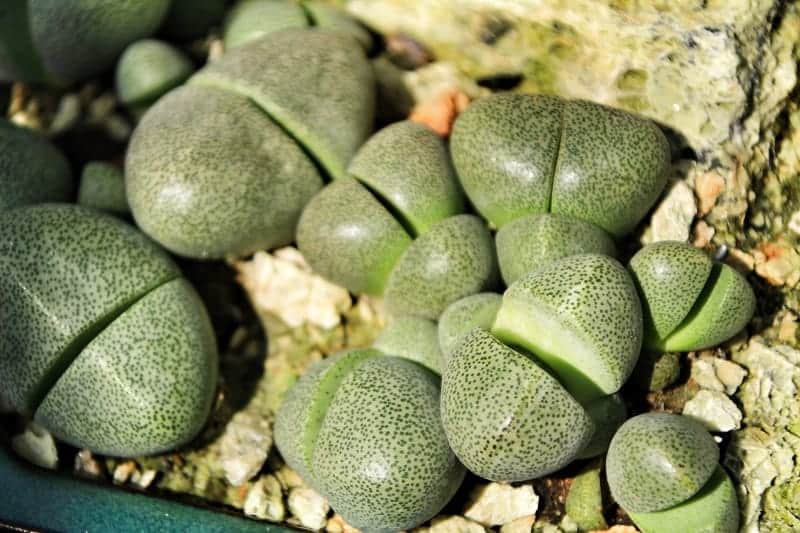
Pleiospilos nelii are petite plants that only reach a little over three inches in height and four inches in diameter at maturity. The plant is stemless and has either two or four leaves, which grow opposite from each other.
The leaves of the Split Rock are hemispherical and are usually grayish-green or brownish in color. They are also covered in tiny dark-colored spots.
The leaves grow in pairs as the old leaves die away. A new pair is grown by the plant every year.
One of the most distinctive characteristics of the Split Rock Succulent are the large, vibrantly colored blooms that emerge from the plant’s center.
The flowers are similar in shape to a daisy and are usually yellowish orange in color, but pink or white is possible too. They can reach up to three inches in diameter, making them quite large in comparison to the plant itself. Some gardeners compare their scent to that of coconuts.
The blooms are only open for a short time each day. They typically open up sometime during the afternoon and close at sunset. Split Rocks usually bloom somewhere between early spring and the middle of summer, but it’s not uncommon for them to bloom in the fall too.
Another great feature of Split Rock Succulents is that they are non-toxic to pets, so if you share your home with furry friends, you won’t need to worry about them should they accidentally take a bite out of one of your plants.
Split Rock Cultivars
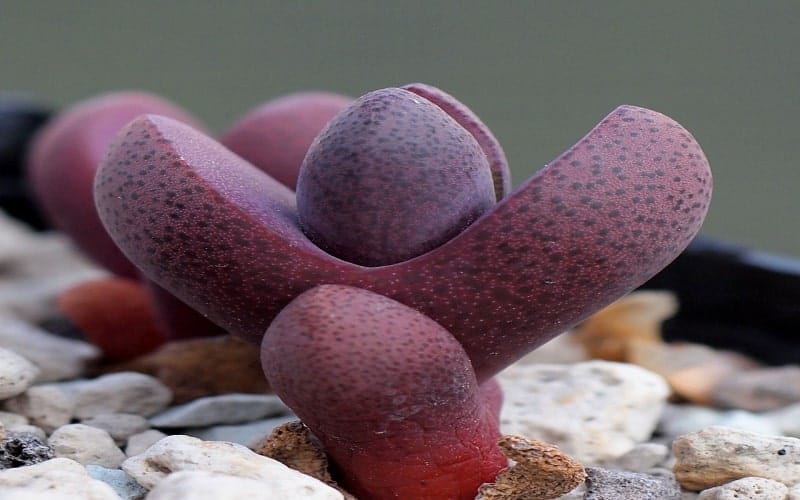
If the normal greenish-gray Split Rock doesn’t appeal to you, consider Pleiospilos nelii ‘Royal Flush’. This cultivar is similar in size and shape to the original plant, but the leaves are more of a pinkish purple color.
When in bloom, Royal Flush produces pink blooms instead of the usual yellow or orange flowers.
Royal Flush develop the most vibrant coloring with adequate sunlight, so in order to achieve the vibrant pink and purple shades it must be grown in an area with as much sunlight as possible.
Caring for Split Rock Succulents
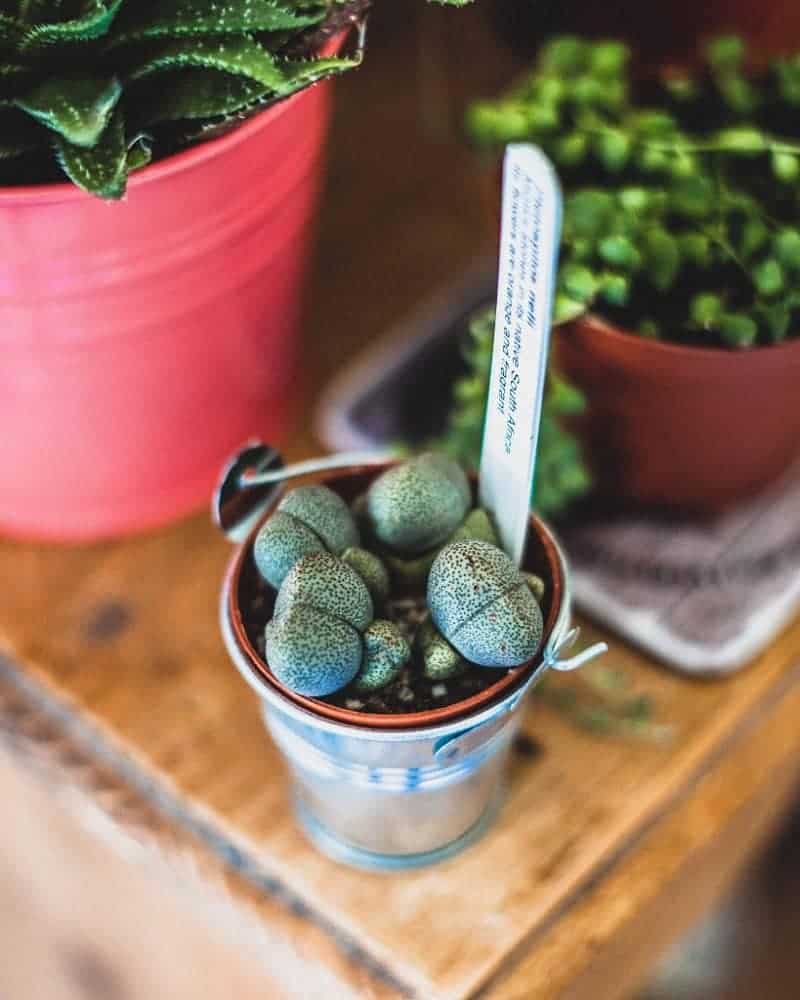
Like other mesembs, Split Rock Succulents aren’t the easiest plants to care for. However, if you can imitate the same type of neglect they receive in the wild, you should be able to keep them alive.
Mesembs have a reputation for being some of the most difficult succulents to care for, so if you’re ready for a challenge, bring a Split Rock Succulent into your home.
Light
No products found.
Split Rock Succulents love bright light. Remember, they’re used to living in arid environments with no shortage of sunshine.
When grown indoors, partial to full sun is ideal. If you have a south-facing window in your home, that would be the perfect place to grow your Split Rock Succulent.
If a south-facing window isn’t an option, you may need to supplement natural light with grow lights, depending on how much sun your other windows get.
If grown outdoors in appropriate climates, Split Rock Succulents will thrive in full sun but will do best if they can be brought inside or sheltered during rainy or cold weather.
Water
The most common reason that gardeners struggle to keep their mesembs alive is due to their unique water needs. Obviously, most succulents require less frequent watering than other types of houseplants, but mesembs like the Split Rock Succulent need even less.
In an ideal environment, Split Rock Succulents should only be watered during their growing seasons, which are in the spring and fall. Water should be withheld during winter and during the heat of the summer, resuming once the temperatures cool down or warm up again.
Split Rock Succulents absolutely cannot tolerate damp soil, so standing water and frequent watering should be avoided at all costs. The soil should always be completely dry before watering this plant again.
One of the signs of overwatering is the number of leaves on the Split Rock Succulent. Leaves grow in pairs and are replaced as the plant grows new pairs and sheds the old ones. If a Split Rock Succulent has more than four leaves, it’s possible it’s receiving too much water and it’s at risk of rotting.
The reason for this is that when the old leaves are shed, they’re actually consumed by the plant as nutrition. When a Split Rock has too many leaves, it’s referred to as “stacking”.
So if the plant is getting a lot of water, it may not need to consume the old leaves. This may not seem like much of a problem, but it’s a sign that the plant is getting more water than it really needs.
A Split Rock with more than four leaves might be interesting to look at, but it’s not natural for the plant and should be avoided. Stacking may eventually lead to rot.
It should be mentioned that you should never manually remove excess leaves from your Spit Rock Succulent. If it has too many leaves, you can simply stop watering it to allow it to absorb the water and nutrients from the extra leaves.
This will eventually cause the leaves to dry out and fall off, which is exactly what you want. If you’ve purchased your Split Rock with too many leaves or have accidentally overwatered it, it’s best just to leave it be until it returns to the more normal number of two to four leaves.
If you grow your Split Rock Succulent outdoors, you should consider planting it in a container, rather than in the ground. This is so that you can move the plant indoors during rainy weather, which may provide the plant with more water than it needs and cause the roots to rot.
Gardeners who are committed to growing their Split Rocks outdoors in the ground have found ways to get around the need for little water. Some gardeners actually grow their Split Rock Succulents under glass or plastic or have some readily available should rainy weather appear in the forecast.
If you want to keep your Split Rock Succulent alive, the most important aspect of its care is controlling its water intake. If you can make sure it doesn’t get any more water than necessary, you have a much better chance of keeping the plant alive and thriving.
Temperature

Split Rock Succulents are warm-weather plants that will not tolerate freezing temperatures. As with rainy weather, if you’re expecting colder than normal temperatures, it may be best to bring your outdoor Split Rocks inside until it warms up.
If you live in a colder climate, it may not be possible to grow your Split Rock Succulents outdoors. Most indoor environments are warm and consistent enough in temperature for these plants to thrive.
It’s recommended to only grow Split Rock Succulents outdoors if you live in USDA temperature zones 9-10. These plants can easily tolerate hot weather but will suffer if temperatures drop toward freezing.
Soil
As with most succulents, Split Rock Succulents need well-draining soil. However, they will do best in soil that drains much faster than most cactus or succulent potting mixes. In fact, the less organic matter in the soil, the better.
There are very few commercial potting mixes that will work for mesembs, so it’s usually best to make your own mixture to provide your Split Rock Succulents with the best substrate.
Most gardeners recommend using a mixture that is around 20-25% cactus soil and 75-80% inorganic matter such as pumice or gravel. Remember, these plants naturally grow in rocky soil with little organic matter to feed on.
Unfortunately, this isn’t a plant that can grow successfully in a container with other succulents unless those other plants are also mesembs with the same needs in terms of water and drainage.
Soils containing water-absorbing materials such as peat moss should be avoided at all cost. They’re a surefire way to overwater your Split Rock and encourage it to stack or rot.
It’s also worth mentioning that you should absolutely not put rocks in the bottom of your pot to encourage better drainage. This will, in fact, raise the water table, which will put your Split Rock Succulents at risk of rot.
If you have adequately draining soil and the right kind of container, you don’t need to take any additional steps to encourage drainage. If you do need your plant to drain faster, you’re probably overwatering it anyway.
Type of Container
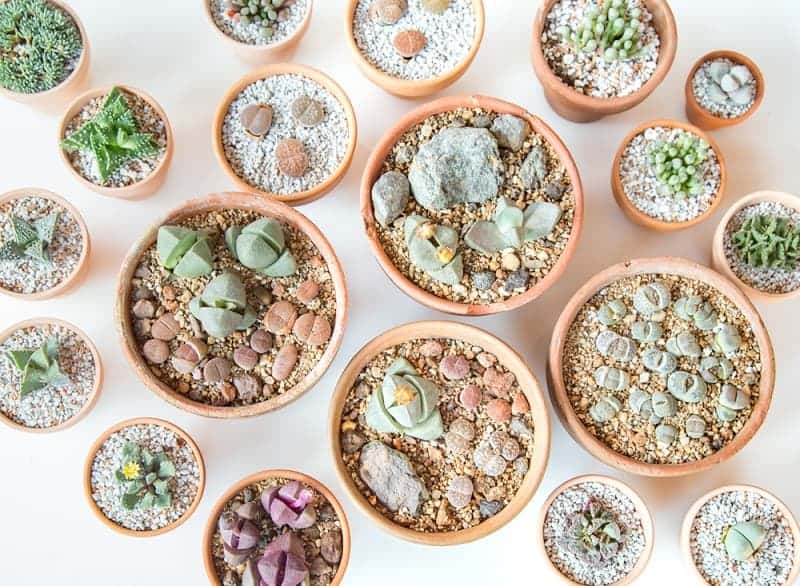
Split Rock Succulents do not have extensive root systems and are not large plants, so they can survive in relatively small containers. However, the pots should be deep enough for them to grow a long tap root without running out of space.
It’s recommended to grow Split Rocks in a pot that is at least three to four inches deep. This will provide enough room for the roots to grow properly, but not so large that the pot retains excess moisture.
There is no single best type of container for Split Rock Succulents. Some gardeners use ceramic pots while others use terracotta. Plastic pots will also work well too.
The most important feature of the pot you choose for your Split Rocks is drainage. Split Rock Succulents should not be grown in containers without drainage holes. This is just asking for trouble.
If you’re interested in drilling drainage holes in your pots that don’t have them, it’s not a difficult process, but it could save your succulent’s life someday.
Propagating Split Rock Succulents
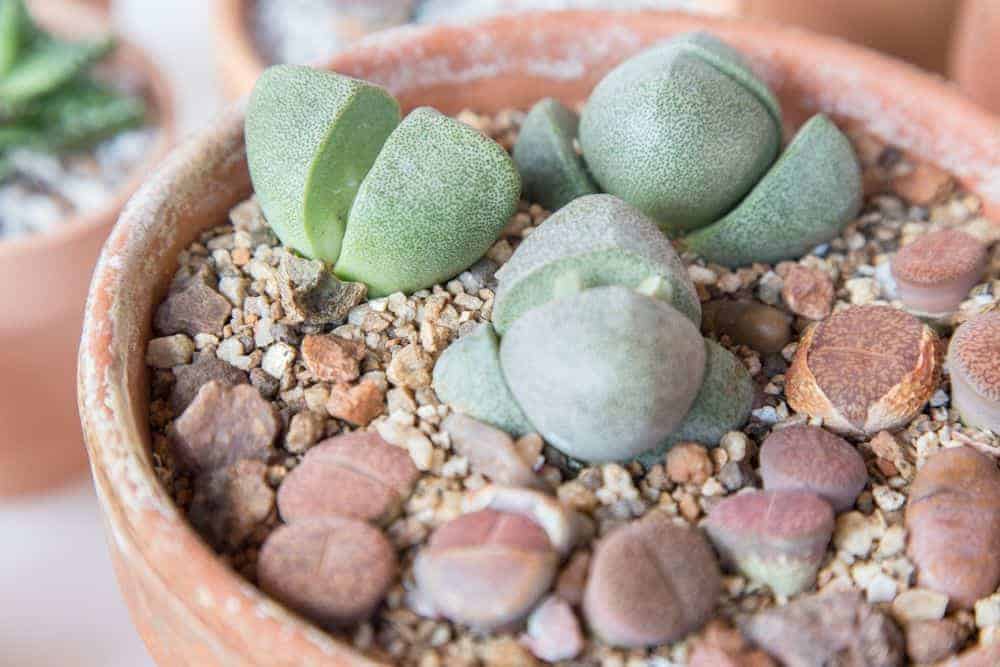
Unlike many other types of succulents, there aren’t many options in terms of propagating Split Rock Succulents. Propagation is only possible using one of two methods: offsets and seeds. As a stemless succulent with few leaves, leaf cuttings are not a viable propagation method with this type of plant.
Offsets
Split Rock Succulents do produce offsets, but it’s quite rare, so this isn’t a propagation method that can be relied upon. However, if your Split Rock Succulent does produce pups, this is a sign that you’re doing a great job taking care of it.
Split Rocks only produce offsets when conditions are optimal. If you see offsets around your plant, this is essentially a sign that your plant has enough resources to produce a new plant without risking the health of the mother plant.
When the offsets are big enough that you feel comfortable transplanting them, typically prior to the growth season, you can separate them from the mother plant.
Offsets should be separated from the mother plant at a point as close to the mother plant as possible. You want to try to include as much of the pup’s root system as possible to increase its chances of survival.
Cut the offset away using a clean, sharp knife or set of shears or scissors. Knives are typically best as they require less room for maneuvering, which puts tiny plants at less of a risk of being accidentally damaged.
After the offsets have been separated from the mother plant, it’s best to let them dry out for a few days to allow the cuts to callous. This protects the tiny plants from any potential pathogens that could enter through the open wound.
Once the cuts have calloused, the Split Rock pups can be transplanted to their own containers. Since they’re essentially just tiny versions of the mother plant, their care will be similar to that of a mature Split Rock Succulent.
It’s usually recommended to water a recently transplanted Split Rock Succulent to help encourage it to root and establish itself in its new container. Now, this doesn’t mean you can overwater it, but a single deep watering before returning to a normal watering schedule is plenty.
Seeds
If you’re interested in propagating Split Rock Succulents, the most common method is to grow them from seeds. You can either collect the seeds from the seed pods on your current plants or buy new seeds online. Split Rock Succulent seeds are widely available to purchase, so you shouldn’t have any trouble finding them.
If you’d prefer to collect your own seeds, read our guide on collecting succulent seeds from flowers.
The best time to sow your Split Rock seeds is during the summer. Sow the seeds in the same type of soil as you plant a mature Split Rock in.
To help ensure the success of your seeds, some gardeners recommend soaking the seeds in water for about 24 hours prior to planting. After soaking, the seeds can be placed in fast-draining soil.
Initially, damp soil will encourage the seeds to germinate, but once the seedlings have sprouted, you can cut back watering to prevent rot. Germination can take quite some time, so it’s important to be patient during this time.
Common Split Rock Succulent Pests and Problems

As previously mentioned, the most common problem with Split Rock Succulents is overwatering. Overwatering will lead to root rot, which most plants will not survive.
If you suspect that you’ve accidentally overwatered your Split Rock Succulent and are certain that it hasn’t yet begun to rot, treatment is as simple as allowing the plant to dry out. Again, if the plant has produced too many leaves, you can simply ignore it and allow it to absorb water from the extra leaves when it needs to.
Another risk of overwatering your Split Rock Succulents is that the decay of a rotting plant and moist soil creates the ideal environment for a variety of common succulent pests. Practicing good plant hygiene along with proper watering techniques will help minimize the chances of your Split Rock Succulents becoming infested with pests.
When bringing any new plants into your home, it’s best to quarantine them in an area far away from your succulent collection for at least two weeks. By keeping the new plants separated, you can treat that single plant for pests should they appear instead of having to treat your entire collection.
Remember, a pest infestation can spread rapidly, and treatment can be a long and frustrating endeavor. Additionally, it puts your precious plants at risk of being permanently damaged by the pests. Though it may seem unnecessary at times, quarantining is the best method of preventing pests from spreading.
You Might Also Like:

